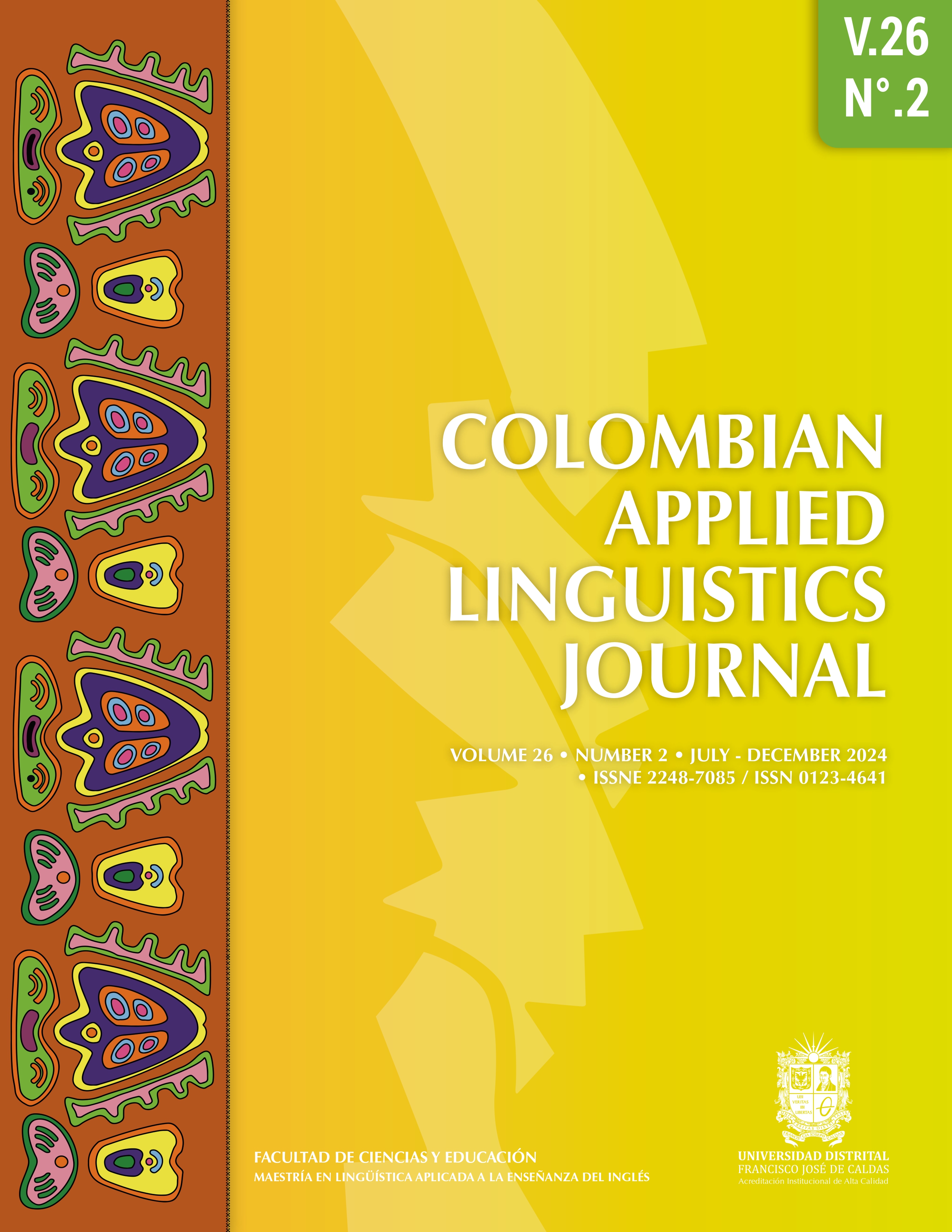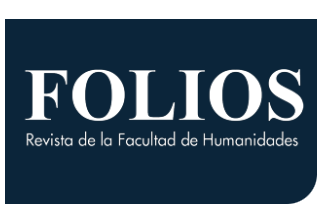DOI:
https://doi.org/10.14483/22487085.21210Published:
2024-08-30Issue:
Vol. 26 No. 2 (2024): CALJ : july-decemberSection:
Research ArticlesInvestment in Learning English as an Additional Language
A Study with Pre-service Teachers
El Investment de los Estudiantes en el Aprendizaje de Inglés como Lengua Adicional
Keywords:
Inversión, aprendizaje de lenguas adicionales, comunidades de aprendices, profesores en formación (es).Keywords:
Investment, additional language learning, communities of learners, pre-service teachers, identity (en).Downloads
Abstract (en)
Learning additional languages is an experience and a process influenced by numerous aspects. This article presents a qualitative case study focused on the aspects influencing the investment of seven learners of English as an additional language, all of whom are pre-service teachers pursuing bachelor’s degrees in English education. The data under consideration is part of a larger intervention-based action research study that explored the language learning experiences of twenty pre-service teachers enrolled in a teacher preparation program at a public university in Colombia. The study is grounded in Darvin
and Norton’s (2015) concept of investment and highlights the significance of communities of practice (Wenger, 2011). We analyzed open-ended interviews using Saldaña’s (2016) coding framework. The findings suggested that the investment of additional language learners can be influenced by their teachers’ pedagogical practices, the learning communities created by teachers, and the learners’ own imagined selves or identities. We discussed the implications of these findings for language teachers, language centers or institutes, and teacher education programs.
Abstract (es)
El aprendizaje de idiomas es una experiencia y un proceso influenciado por una variedad de aspectos. Este artículo presenta un estudio de caso cualitativo enfocado en los aspectos que influyeron el compromiso (investment) de siete estudiantes de un programa de licenciatura en inglés como lengua adicional en su aprendizaje del idioma. Los datos considerados provienen de un estudio más amplio que investigó las experiencias de aprendizaje de idiomas de los futuros profesores de inglés como lengua extranjera en una universidad pública colombiana. Tomando como base el modelo de investment de Darvin y Norton (2015), se resalta el impacto de las comunidades de práctica en el aprendizaje de una lengua adicional (Wenger, 2011). En el estudio, se analizó entrevistas abiertas realizadas con los participantes utilizando el marco de codificación de Saldaña (2016). Los hallazgos sugieren que este compromiso puede estar influenciado por las prácticas pedagógicas de
los docentes, las relaciones dentro de las comunidades de práctica que los docentes crean y los imaginarios e identidades de cada estudiante. Analizamos las implicaciones para los profesores de idiomas, los centros o institutos de idiomas y los programas de formación docente.
References
Abi, M. T. (2019). A study on factors affecting students’ English language learning motivation in a multilingual context at a private university in East Timor. Asian Journal of Literature, Culture and Society, 9(1), 45-78.
Agarwal, S., & Krishan, R. (2014). Influence of environments on the English learning of students in India. International Journal on Arts, Management and Humanities, 3(1). 5-8.
Bacon, H. R., & Kaya, J. (2018). Imagined communities and identities: A spaciotemporal discourse analysis of one woman’s literacy journey. Linguistics and Education, 46, 82-90.
Becirovic, S. (2017). The relationship between gender, motivation and achievement in learning English as a foreign language. European Journal of Contemporary Education, 6(2), 210-220.
Basque, M., & Bouchamma, Y. (2016). Predictors of mathematics performance: The impact of prior achievement, socioeconomic status and school practices. International Studies in Educational Administration, 44(1), 85-104.
Benjumea, C. de. (2015). The quality of qualitative research: From evaluation to attainment. Texto & Contexto - Enfermagem, 24(3), 883–890. https://doi.org/10.1590/0104-070720150001150015
Boylan, M. B. (2017). The impact of learning communities on student and faculty engagement: The case for linking college success and basic skills English courses at “a” community college [PhD dissertation, Rowan University]. ProQuest Dissertations Publishing.
Carrillo, C. (2020). El filtro afectivo positivo como estrategia de estimulación neurocognitiva para la modificación de conductas negativas en un niño con discapacidad. Universidad Libre. https://hdl.handle.net/10901/18678.
Cents-Boonstra, M., Lichtwarck-Aschoff, A., Denessen, E., Aelterman, N., & Haerens, L. (2021). Fostering student engagement with motivating teaching: An observation study of teacher and student behaviours. Research Papers in Education, 36(6), 754-779.
Darvin, R., & Norton, B. (2015). Identity and a model of investment in applied linguistics. Annual Review of Applied Linguistics, 35, 36-56. doi:10.1017/S0267190514000191
Darvin, R., Norton, B. (2017). Language, identity, and investment in the twenty-first century. In T. McCarty & S. May. (Eds), Language policy and political issues in education (pp. 1-15). Springer.
Darvin, R., & Norton, B. (2021). Investment and motivation in language learning: What’s the difference? Language Teaching, 1–12.
Dornyei, Z., & Ushioda, E. (2011). Teaching and researching motivation. (2nd ed.). Routledge.
DuFour, R., & Marzano, R. J. (2011). Leaders of learning: How district, school, and classroom leaders improve student achievement. Solution Tree Press.
Dunn, R., & Honigsfeld, A. (2013). Learning styles: What we know and what we need. The Educational Forum, 77 (2), 225-232. https://doi.org/10.1080/00131725.2013.765328
Ebneyamini, S., & Sadeghi Moghadam, M. R. (2018). Toward developing a framework for conducting case study research. International Journal of Qualitative Methods. https://doi.org/10.1177/1609406918817954
EF EPI 2021 – EF English Proficiency Index – Colombia. (2021). EF English Proficiency Index. https://www.ef.com/wwen/epi/regions/latin-america/colombia/
Enciso, L., Paya, L., & Vargas, S. (2021). La real situación del bilingüismo en Colombia [Documento de trabajo, Universidad EAN]. http://hdl.handle.net/10882/10833
Faragher, R., & Van Ommen, M. (2017). Conceptualising educational quality of life to understand the school experiences of students with intellectual disability. Journal of Policy and Practice in Intellectual Disabilities, 14(1), 39-50.
Ghavamnia, M., & Kashkouli, Z. (2022). Motivation, engagement, strategy use, and L2 reading proficiency in Iranian EFL learners:
An investigation of relations and predictability. Reading Psychology, 43(7), 423-441.
Ghonsooly, B., Hassanzadeh, T., Samavarchi, L., & Hamedi, S. M. (2017). A mixed-methods approach to demotivating factors
among Iranian EFL learners. Issues in Educational Research, 27(3), 417-434.
Harrell, M. C., Bradley, M., Rand Corporation, & National Defense Research Institute. (2009). Data collection methods. RAND.
Henter, R. (2014). Affective factors involved in learning a foreign language. Procedia-social and Behavioral Sciences, 127, 373-378.
Hoff, E. (2006). How social contexts support and shape language development. Developmental Review, 26(1), 55–88. https://doi.org/10.1016/j.dr.2005.11.002
Inada, T. (2021). Target language use in communicative English lessons: The emotional perspective. English Language Teaching, 14(11). 1-8. https://doi.org/10.5539/elt.v14n11p1
Kaya, J., & Olaya, A. (2024). Promoting pre-service teacher development through intervention-based action research. Learning: Research and Practice, 1-17. https://doi.org/10.1080/23735082.2024.2357553
Kiatkheeree, P. (2018). Learning environment for second language acquisition: Through the eyes of English teachers in Thailand. International Journal of Information and Education Technology, 8(5), 391–395. https://doi.org/10.18178/ijiet.2018.8.5.1069
Lave, J., & Wenger, E. (1991). Situated learning: Legitimate peripheral participation. Cambridge University Press.
Lee, E. J. E. (2014). Motivation, investment, and identity in English language development: A longitudinal case study. System, 42 (1), 440-450. https://doi.org/10.1016/j.system.2014.01.013
Ministerio Educación Nacional (2014). Colombia Very Well! Programa Nacional de Inglés (2014).
Nash, R. (2014). The active classroom: Practical strategies for involving students in the learning process. Corwin.
Newton, P. M., & Miah, M. (2017). Evidence-based higher education: Is the learning styles ‘myth’ important? Frontiers in Psychology, 8(444), 1-9.
Norton, B. (2013). Identity and language learning: Extending the conversation. Multilingual Matters.
Norton, B., & De Costa, P. (2018). Research tasks on identity in language learning and teaching. Language Teaching, 51(1), 90-112. https://doi.org/10.1017/S0261444817000325
Norton, B. (2000). Identity and language learning: Gender, ethnicity and educational change. Pearson.
Norton, B., & Toohey, K. (2011). Identity, language learning, and social change. Language Teaching, 44(4), 412-446. doi:10.1017/S0261444811000309
Norton, B. (2015). Identity, investment, and faces of English internationally. Chinese Journal of Applied Linguistics, 38(4), 375-391.
Pashler, H., McDaniel, M., Rohrer, D., & Bjork, R. (2008). Learning styles: Concepts and evidence. Psychological Science in the Public Interest, 9(3), 105-119.
Pate, M., Wagers, S., Owen, S., & Simpkins, C. (2019). Learning in a community: Evidence of the effectiveness and challenges of learning communities. Journal of Criminal Justice Education, 31(2), 187–207. https://doi.org/10.1080/10511253.2019.1692881
Pavlenko, A., & Norton, B. (2007). Imagined communities, identity, and English language learning. In J. Cummins & C. Davidson (Eds.), International handbook of English language teaching (pp. 669-680). Springer.
Posada, J. (2018). Exploring imagined communities, investment and identities of a group of English language pre-service teachers through autobiographies. In ELT local research agendas I (pp. 63-87). Universidad Distrital Francisco José de Caldas.
Reeves, D. B. (2020). The learning leader: How to focus school improvement for better results. ASCD.
Rose, H., Curle, S., Aizawa, I., & Thompson, G. (2020). What drives success in English medium taught courses? The interplay between language proficiency, academic skills, and motivation. Studies in Higher Education, 45(11), 2149-2161.
Saldaña, J. (2016). The coding manual for qualitative researchers. Sage.
Schmid, E. C. (2022). ‘I think it’s boring if you now only speak English’: Enhancing learner investment in EFL learning through the use of plurilingual tasks. Innovation in Language Learning and Teaching, 16(1), 67-81. https://doi.org/10.1080/17501229.2020.1868476
Statista Research Department. (2021). The most spoken languages worldwide 2021. https://www.statista.com/statistics/266808/the-most-spoken-languages-worldwide/
Sung, C. C. (2019). Investments and identities across contexts: A case study of a Hong Kong undergraduate student’s L2 learning experiences. Journal of Language, Identity & Education, 18(3), 190–203. https://doi.org/10.1080/15348458.2018.1552149
Wenger, E. (1998). Communities of practice: Learning, meaning, and identity. Cambridge University Press.
Wenger, E. (2011). Communities of practice: A brief introduction. Scholars’ Bank, 1-7. http://hdl.handle.net/1794/11736
Yin, R. (2015). Qualitative research from start to finish. Guilford.
How to Cite
APA
ACM
ACS
ABNT
Chicago
Harvard
IEEE
MLA
Turabian
Vancouver
Download Citation
Metrics
License
Copyright (c) 2024 Pedro Felipe Ortega Prieto, Maria Angelica Hernandez Vargas, Jean Kaya, Dr. Olaya

This work is licensed under a Creative Commons Attribution-NonCommercial-NoDerivatives 4.0 International License.
This work is licensed under a Creative Commons Attribution-NonCommercial-NoDerivatives 4.0 International License.
Attribution — You must give appropriate credit, provide a link to the license, and indicate if changes were made. You may do so in any reasonable manner, but not in any way that suggests the licensor endorses you or your use.
NonCommercial — You may not use the material for commercial purposes.
NoDerivatives — If you remix, transform, or build upon the material, you may not distribute the modified material.
The journal allow the author(s) to hold the copyright without restrictions. Also, The Colombian Apllied Linguistics Journal will allow the author(s) to retain publishing rights without restrictions.









